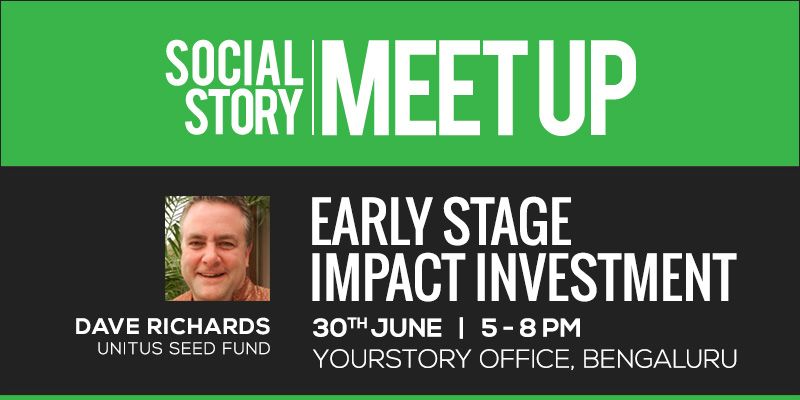View from the other side – SocialStory’s meetup with Dave Richards
SocialStory organized a meetup for social enterprises and entrepreneurs alike with Dave Richards, Co-Founder and Managing Partner, Unitus Seed Fund as the speaker. The agenda was to get a peek into the world of investors and their perspective on various aspects of starting up.

We started with the burning question in everyone’s mind – What do investors look for in a startup for early stage investing? Dave structured his response in terms of what questions go through an investor’s mind when evaluating a startup for early stage investing.
The Team – Do they have vision, capability and the capacity to see it through?
This is something that investors struggle with, the idea may be very good but can this team do it? What’s different about them? What helps is the things you’ve done in the past, insights or skills you’ve had or developed that position you to be better than someone else to go figure out this problem.
Traction – Are people (customers) willing to put their money down?
“We don’t invest in ideas. There are a lot of ideas out there. We’re trying to see if you’ve gone and put some sweat into a prototype or at least an initial PoC(proof of concept)”. If the team speaks to a customers, and has the data that shows that there is demand for the idea/service/product where people will pay for it, then the team is successful in validating their idea. “There is a difference between need and demand. People want a lot of things, but if they’re willing to put down money for something, then you’ve got real traction. ”
What is the potential for scale?
This is an answer that varies from investor to investor. Dave said that, for early stage investment they always look at the scale. If something is built for the masses, then it is something that interests them.
Has the team done their homework?
“It is extremely important to be aware of who is doing what (in the space the entrepreneur is). What is the solution? Why is working/not working?” When a team comes with these answers, it tells the investors that the team really does know what they’re talking about. Dave adds,
Even better than that is when you tell how you’re different and how the other guy won’t be able to beat you in the game.
Who will put in the next big check?
According to Dave as a model, they invest early, but they always look at who will be the larger investor who will come and invest in the company. He says, “We’re interested in the next 12-18 months in which what is it that I’ll interest the next investor.”
Challenges in scaling and profitability
“Unit economics is key to scale”. Citing an example of Hippocampus, the leading provider of education in preschools and after school tuition in rural areas, Dave told us that what they did right. – With extensive market research, they understood the exact price point beyond which rural customers could not pay. Then, they figured how to deliver the best solution under that price point. They also broke down all the costs to them and calculated how long every rupee would take to come back. This money (the return) was used to scale more quickly. Dave adds,
Understanding and being a master of the unit economics both where you are now and where and how you will get to. That’s how an entrepreneur should think about unit economics.
Behavioural patterns are also interesting to watch. Reverse Economics can sometimes baffle the entrepreneur – After working so hard to bring the price point down and yet deliver a quality product, customer’s perception can sometimes stump you – if something is expensive or beyond a certain price point, it’s a better product. Dave quips, “This is behaviour and behaviour is very hard to change”. The entrepreneurs have to work to deliver the products that not only are cheap enough so that they hit the sweet spot for the customer, but they must also deliver high quality and value in the customer’s mind.
Pointers from the Q&A with the audience
Dave also mentioned that investors often ask startups about the cost of customer acquisition and the Life time Value (LTV) of that customer. “Once you’ve acquired a customer, the enterprise must know how much revenue you can generate from that customer – repeat cycles, how much do they buy, &etc.”
What’s important and understood is that the LTV must always be greater than the cost of customer acquisition – the bigger the difference is, you can spend more in acquiring other customers. Busting a misconception, Dave said that there is actually reverse economies of scale in customer acquisition!
People often think that as they scale, their cost of acquisition per customer will be lesser. It’s quite the opposite, simply because you’ve already bagged the early adopters first and are now going after people who necessarily might not need your product, they’re more expensive to acquire. With cost of customer acquisition rising with more players entering the market in the same area, the LTV must always continue to rise to beat the competition.
Another point that entrepreneurs often overestimate is the profit margin that they have in the product line. Most times the cost ends up being higher than what they anticipated due to various things that probably weren’t factored in. Dave’s advice to entrepreneurs,
If you believe that your business needs a certain profit margin to survive, you should probably target more than that to compensate for the unseen costs that you might have missed out on. This means that you may have to charge your customer more than you originally planned to.
“The businesses should get past the point of raising money. You’re going to have to generate profits and that’s the surplus that can be reinvested in your business to make it keep going strong. So, you should work to get to a point where your profits are enough and you don’t need to raise more money from investors then. Profits become your working capital, they’re the ways that you can more organically grow your business without having to go to an investor.”
Is the bubble about to burst?
The past decade has seen a spike in the entrepreneurial ecosystem, and the last couple of years seem to have been a great time to be around for enterprises and entrepreneurs with more and more investment happening in India. With exponential growth, there is always a risk of when the bubble might burst. Dave answers,
I think it’s on the rise. I don’t think it’s bursting because the startup ecosystem is still relatively young in India. There are huge opportunities here.
Interestingly, Dave pointed out that while Bangalore is still the startup capital of India the ecosystem is on the rise in other cities and tier 2 cities like Coimbatore, Cochin, Bhubhaneshwar, Jaipur, Madurai.
On a parting note, Dave said that it is great to see young graduates from b-schools come out and look at entrepreneurship and startups as a lucrative career option. It’s a positive change and one that was long in the making.











